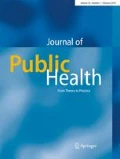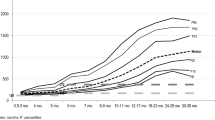Abstract
Aim
To investigate predictors of compliance with the recommendation that all infants in Ireland are supplemented daily from birth to 12 months of age with 5 μg of vitamin D.
Subjects and methods
A prospective observational study was conducted. Self-complete questionnaires recorded socio-demographic characteristics, health behaviours and supplementation practices for 158 mother-infant dyads at 4, 9 and 12 months post-partum. A 2-day food diary was also obtained on 12-month-old infants to examine the contribution of diet to vitamin D intakes.
Results
At 4, 9 and 12 months of age, 57.6% (n = 91), 34.2% (n = 54) and 23.4% (n = 37) of infants, respectively, were supplemented as recommended. In multivariate analyses, receiving supplementation advice from health professionals in the early post-partum period was the most significant predictor of correctly supplementing 4-month-old [p < 0.01; odds ratio, OR: 61.94 (95% confidence interval, CI: 11.53–332.83)], 9-month-old [p < 0.01, OR: 10.30 (95% CI: 2.29–46.27)] and 12-month-old [p = 0.04, OR: 3.85 (95% CI: 1.05–14.08)] infants. Amongst 12 month olds, mean intakes from diet and supplementation combined (7.6 ± 4.7 μg/day) were suboptimal.
Conclusion
Suboptimal vitamin D supplementation practices were evident throughout infancy. Dietary intakes of vitamin D did not compensate for suboptimal supplementation practices. Supplementation practices may improve if health professionals advocate safe supplementation during routine infant health checks.

Similar content being viewed by others
Change history
06 February 2018
The authors wish to clarify that J.M. Kearney refers to John M. Kearney. The first name of this author was not clarified in the original article. The authors apologise for this error.
References
Abraham C, Sheeran P (2005) The health belief model. In: Conner M, Norman P (eds) Predicting health behaviour. Open University Press. Berkshire, England, pp 28–80
Arditi C, Rège-Walther M, Wyatt JC, Durieux P, Burnand B (2012) Computer-generated reminders delivered on paper to healthcare professionals; effects on professional practice and healthcare outcomes. Cochrane Data Syst Rev. https://doi.org/10.1002/14651858.CD001175.pub3
Barbour RS, Macleod M, Mires G, Anderson AS (2012) Uptake of folic acid supplements before and during pregnancy: focus group analysis of women’s views and experiences. J Hum Nutr Diet 25:140–147
Bener A, Al-Hamaq AOAA, Saleh NM (2013) Association between vitamin D insufficiency and adverse pregnancy outcome: global comparisons. Int J Women Health 5:523–531
Bennett AE, O’Connor AL, Canning N, Kenny A, Keaveney E, Younger K, Flynn MA (2012) Weaning onto solid foods: some of the challenges. Ir Med J 105:266–268
Burrows TL, Martin RJ, Collins CE (2010) A systematic review of the validity of dietary assessment methods in children when compared with the method of doubly labeled water. J Am Diet Assoc 110:1501–1510
Christesen HT, Elvander C, Lamont RF, Jørgensen JS (2012) The impact of vitamin D in pregnancy on extraskeletal health in children: a systematic review. Acta Obstet Gynecol Scand 91:1368–1380
Cooper C, Javaid MK, Taylor P, Walker-Bone K, Dennison E, Arden N (2002) The fetal origins of osteoporotic fracture. Calcif Tissue Int 70:391–394
Food Safety Authority of Ireland (2007) Recommendations for a national policy on vitamin D supplementation for infants in Ireland. Author, Dublin
Food Safety Authority of Ireland (2011) Scientific recommendations for a national infant feeding policy, 2nd edn. Author, Dublin
Fulford B, Macklon N, Boivin J (2014) Mental models of pregnancy may explain low adherence to folic acid supplementation guidelines: a cross-sectional international survey. Eur J Obstet Gynaecol Reprod Biol 176:99–103
Gallo S, Vanstone CA, Weiler HA (2012) Normative data for bone mass in healthy term infants from birth to 1 year of age. J Osteoporos; ID 672403
Gandhi TK, Sequist TD, Poon EG, Karson AS, Murff H, Fairchild DG, Kuperman GJ, Bates DW (2003) Primary care clinician attitudes towards electronic clinical reminders and clinical practice guidelines. AMIA Annu Symp Proc 848
Grimes DA, Schulz KF (2002) Bias and causal associations in observational research. Lancet 359:248–252
Health Service Executive (2010) Policy on vitamin D supplementation for infants in Ireland, 2010. Available from: https://www.hse.ie/eng/health/child/vitaminD/Vitamin%20D%20Policy.pdf. Accessed 17 July 2015
Health Service Executive (2017) A guide to your child’s growth and development. Available from: http://www.hse.ie/eng/health/child/cfyb/2-5yrs/growthdevelopment/. Accessed 10 December 2017
Institute of Medicine (2010) Dietary reference intakes for calcium and vitamin D, 1st edn. The National Academies Press, Washington DC
Irish Universities Nutrition Alliance (2012) National pre-School Nutrition Survey: summary report. Author, Cork
Kenealy T, Arroll B, Petrie KJ (2005) Patients and computers as reminders to screen for diabetes in family practice. J Gen Intern Med 20:916–921
Kersting C, Weltermann B (2016) Electronic reminders to facilitate longitudinal care: a mixed-methods study in general practices. BMC Med Inform Decis Mak 16:148
Malek L, Umberger W, Makrides M, Zhou SJ (2016) Poor adherence to folic acid and iodine supplement recommendations in preconception and pregnancy: a cross-sectional analysis. Aust N Z J Public Health 40:424–429
McKeating A, Farren M, Cawley S, Daly N, McCartney D, Turner M (2015) Maternal folic acid supplementation trends 2009-2013. Acta Obstet Gynecol Scand 94:727–733
Patience S (2015) Promoting vitamin D uptake in infants and children. BJM 23:10S–13S
Sequist TD, Gandhi TK, Karson AS, Fiskio JM, Bugbee D, Sperling M, Cook EF, Orav EJ, Fairchild DG, Bates DW (2005) A randomized trial of electronic clinical reminders to improve quality of care for diabetes and coronary artery disease. J Am Med Inform Assoc 12:431–437
Shojania KG, Jennings A, Mayhew A, Ramsay C, Eccles M, Grimshaw J (2010) Effect of point-of-care computer reminders on physician behaviour: a systematic review. CMAJ 182:216–225
Smith AE (2011) Validation studies of diets of children and adolescents. J Am Diet Assoc 111:1124–1125
Tarrant RC, Younger KM, Sheridan Pereira M, White MJ, Kearney JM (2010) Factors associated with weaning practices in term infants: a prospective observational study in Ireland. Br J Nutr 104:1544–1554
Touskova T, Vytrisalova M, Palicka V, Hendrychova T, Fuska L, Holcova R, Konopacova J, Kubena AA (2015) Drug holidays: the most frequent type of non-compliance with calcium plus vitamin D supplementation in persistent patients with osteoporosis. Patient Prefer Adherence 9:1771–1779
Vashitz G, Meyer J, Parmet Y, Peleg R, Goldfarb D, Porath A, Gilutz H (2009) Defining and measuring physicians’ responses to clinical reminders. J Biomed Inform 42:317–326
Acknowledgements
The authors wish to acknowledge the mothers who participated in this study; their time was greatly appreciated.
Funding
The lead author was funded by a Dublin Institute of Technology Fiosraigh Scholarship. This scholarship was 50% funded by the Dublin Institute of Technology and 50% funded by Danone Nutricia Early Life Nutrition.
Author information
Authors and Affiliations
Corresponding author
Ethics declarations
Ethical approval
All procedures performed in studies involving human participants were in accordance with the ethical standards of the institutional research committees and with the 1964 Helsinki Declaration and its later amendments.
Informed consent
Informed consent was obtained from all individual participants included in the study.
Conflict of interest
The authors have no conflict of interest to declare.
Additional information
The original version of this article was revised: The authors wish to clarify that J.M. Kearney refers to John M. Kearney. The first name of this author was not clarified in the original article. The authors apologise for this error.
Rights and permissions
About this article
Cite this article
Bennett, A.E., Kearney, J.M. Predictors of vitamin D supplementation amongst infants in Ireland throughout the first year of life. J Public Health (Berl.) 26, 577–583 (2018). https://doi.org/10.1007/s10389-017-0891-3
Received:
Accepted:
Published:
Issue Date:
DOI: https://doi.org/10.1007/s10389-017-0891-3




